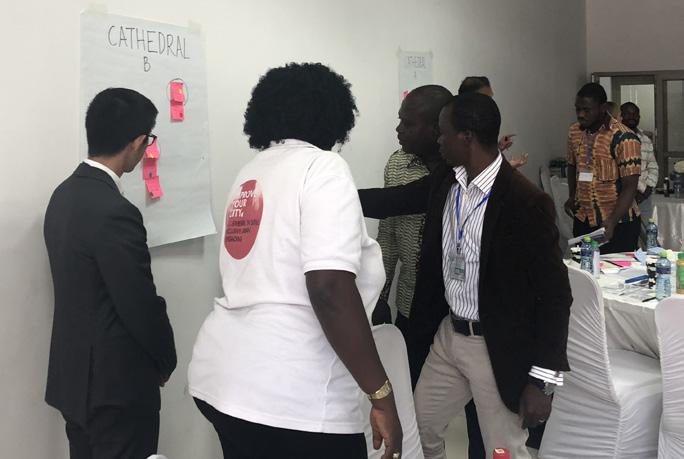
2 minute read
Co-Lab Insights
The WWS team presented many of the above findings to the participants of the Co-Lab hosted by 100RC on November 1-2, 2018 at the AMA Headquarters. The Co-Lab involved both facilitated discussion and presentation activities among tables of different stakeholder groups. To encourage cross-sectoral collaboration, each table contained government officials, local NGO representatives, international experts, WWS team members, and 100RC staff. The groups were first asked to prioritize resilience challenges in Accra. Then, they were asked to brainstorm potential initiatives to address high-priority gaps and create a shortlist of initiatives via voting. Finally, participants formed new teams around the shortlisted initiatives based on their interests and expertise, refined the shortlisted initiatives, and presented their initiatives to a panel of senior AMA officials.
Stakeholders design a new Wato Community Center, one of the ideas generated from the Co-Lab. @ 2018, Kimberly M Noronha (All rights reserved)

Co-Lab participants discuss resilience challenges at Cathedral Junction.
Potential Initiatives
Proposals broadly fell into three categories:
1. Redesigns or upgrades of Wato and Cathedral Junctions;
2. Initiatives to organize or formalize vending; and
3. Placemaking strategies for Wato Junction
Further details of the proposed projects are listed on the opposite page. The specific proposals suggested by the Co-Lab teams and the additional logistical, political and financial constraints that participants shared framed the WWS team’s thinking about the policies recommended in the following chapter.
Implementation Constraints
The Co-Lab provided an opportunity for the WWS team to learn about some of the constraints on the AMA and other stakeholders in implementing new policies. The team noted that:
Decentralization of the AMA’s responsibilities to local councils makes city-wide policies more difficult to coordinate and
implement. Therefore, place-based policies and those that come under the national government directive will be easier to implement in the short-term than those which will require consensus-building and stakeholder engagement across several councils.
Divergent views among the stakeholders about the role of the AMA vis-à-vis vendors revealed that any major change to existing vendor policies may meet with heavy resistance.
Some participants approach vendors with the goal of regulating and controlling vendor behaviors, which may make vendors’ circumstances more precarious. Others would prefer to empower vendors by providing legal protections for their work. Both strategies can generate similar policies, such as new permit or licensing schemes. It should therefore be recognized that such policies could ultimately serve to undermine or strengthen vendors’ position and that any eventual policy changes should be vetted thoroughly by vendor stakeholders to ensure that the stated goals are being achieved.
Serious financial constraints limit the scope of intervention that
can be pursued without additional outside funding, underlining the importance of prioritizing policy objectives.




